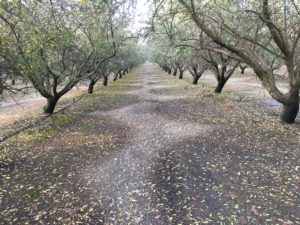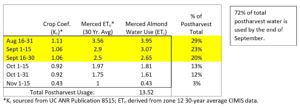
After the hustle of harvest, it is easy to think that the orchard work is nearly wrapped up for the year. With almonds, this isn’t the case. Research over the past 30 years has identified the postharvest period as the primary development period that impacts next year’s crop. Not surprisingly, much of this work has shown proper irrigation practices during this period being the major factor.
For this article, the post-harvest period will be defined as mid-August through early November. During this period, the trees can demand an estimated 12-15″ of water based on location and weather. Roughly 70% this demand is from the six weeks immediately after harvest – when the days are hot and longer (see included table). Shorting trees of water during this period of high water use (mid-August through September) has been shown to significantly reduce next year’s yield. In fact, research by David Goldhamer and Elias Fereras have found that the first 8″ of water applied during the postharvest period is the MOST CRITICAL water applied to maintain orchard yields.

Why is this? Almond floral bud differentiation, unlike other Prunus spp., begins in mid- to late-August and continues through early September. Water shortages during this time reduces carbohydrate development, leading to less energy being able to be directed towards the creation of next year’s flowers, affecting both flower quality and quantity. This, in-turn, leads to an overall reduction in fruit load.
Practices should be employed to keep leaves on the tree through the postharvest period (early November). Reducing tree stress through the harvesting process is the first step in maintaining highly productive trees. This includes being timely with shaking so trees are stressed for a minimal amount of time and understanding the amount of soil moisture and the rate of use – which includes taking into account the wetted area of the irrigation system. After harvest, water should be applied as soon as possible to alleviate stress. This may mean irrigating varieties differently. And finally, in the case of defoliating trees from water stress or mites, water should be applied to re-leaf trees as this has been shown to increase crop load when compared to not applying water.

